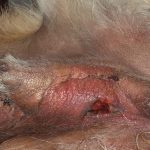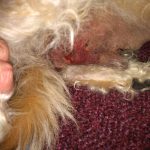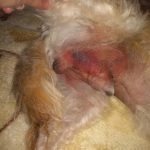I don’t know the answer but wanted to know how his ears are today. Better, I hope?
My dog has a seroma on her abdomen after surgery 2 weeks ago for hiatus hernia. It is starting to reduce in size, now about tennis ball size and she is very well.
She is desperate to exercise, are we OK to take her on walks and for how long? We usually walk her 1-2 hours a day.
Thanks
Comments
Hi Christine Remines here. Sampson’s ears were bothering him so we cleaned them. They were dry and itchy so I put some dog nose moisturizer on them. Now they are swollen like they may have hematoma. Emergency vets on your answering machine … one has an 8-9 hour wait and the other isn’t seeing patients what should I do?
Comments
Hello!! I found Dr Krista’s YT vid (Stripes the cat re nasal polyps) while researching my kitty’s condition. I have had Percy out to Pet ER w. initial thick mucus that became tinged w. a bit of blood. He was prescribed Doxy to treat the infection… it wasn’t until during the course of treatment that he began the “snoring” at which point I rushed him back to Pet ER. Having limited funds and no experience w. these issues ever before, I opted for Labs (figuring that would be a start). Unfortunately, the results did not “tell me anything unusual” and I am not a vet. It was then that I learned about these polyps … and I feel confident that this could be what Percy is suffering from (unless there may be a foreign object obstructing his airway). At this point I have no dx!! I’ve been on the veterinary roller-coaster ride trying to determine the best course of action between my local vet (Dundalk Animal Hosp), Pet ER or another vet altogether… at this point not knowing the cause of his breathing issue or how much the costs may be… I guess I can understand why “estimates” can’t be given … I am just trying to determine the LESS COSTLY route and there seems to be no clear answer. My head is spinning and I want the best for Percy and to NOT have to lose him, that’s the bottom line… my heart is hurting as this was so unexpected!! Would it be possible to fit Percy into the clinic’s busy schedule ASAP?? I called this morning and was told that Monday is already full. Emily advised to reach out on Pawbly … I also sent a pm on FB.
I really need help, I cared for 2 cats last year both former strays, one Main Coon mix w. Hypercardiomyopathy and the other cancer of his paw which was eating away. Both these babies tore my heart in 2 but I did what I had to until it was time to journey on RIP… we had a family of 6 at that time along w. my deceased uncle’s dog. My Care Credit card was easily almost maxed out… my boys and I are pitching in together as many ways as possible for Percy. He is the last of our most recent feline family and I do NOT EVER want to stop caring for animals!! Thank you for my restored faith in humanity!! ~Love~ Shelley & Percy
Comments
Hi my 10 year old rat terrier stomach started to get big I assumed that I was feeding him to much, it just kept getting bigger I ended up taking him to the vet and the vet did an x ray. The mass she showed me on the x ray is pretty big. She said she would do exploratory surgery to see if I can be removed, but if not she just wants to put him to sleep. What are the complications and reasons she would not be able to remove mass?? My dog acts like he is fine he plays runs swims barks eats normal nothing about him seems sick except the giant mass in his stomach!!
Comments
My name is Gail soth i am requesting help for my 1 year old puppy she hasn’t been eating nor drinking throwing up. We had her to churchville vet thursday and Friday og this past week and the emergency hospital in belair Saturday she has had 2 x-rays with suspicion of a object lodged in her intestines. We are trying every way to keep her. We’ve put a lot og money up for her but we don’t have the financials to do the surgery. We love are dog and my youngest 2 grandchildren love her to pieces. We had been trying to feed her through a syringe with her medication the doctors have given us. We want to keep our pup and she means the world to us and shes family. Im pleading for help. This is critical and would appreciate it you could help us save our pup.
Comments
I saw your video on how to deal with an abscess and I tried it, and some little white stuff came out first, but with blood. Then, I squeezed more, but only blood comes out and the more I tried the more he was pulling away, and I figured it was just hurting him, so I stopped. I stopped also because the abscess didn’t seem to get that much smaller after I did it several times. I made an appointment with vet, but they seem to charge a lot more than what your video said, like over $200. Also, I don’t want him to have surgery if that’s what they suggest for two reasons, I don’t want him under and I don’t have the money. I have been unemployed and without unemployment benefits yet since March. What do I do if they say he needs surgery? The dog you had on the video, his abscess looked a lot worse than my dog’s; if that dog didn’t need surgery, why would mine?
Comments
Please could you give me some advise. I got my dog (1year old) castration due to cryptorchidism. Day1 – After the surgery he was very bruised. Day2 – He was happy, eating, drinking but very sore. Day3- Abdomen started to swell. Day4- Abdomen was very swollen, bruised and slight clear weeping from incision. Visited the vet who said it was fine. Day5- Extreme swelling (see pic) so I took him to the vet again who give more pain/inflammation meds. Day6 -Swelling has ruptured leaving a whole in his abdomen (see pic) Visited the vet again who give 6 day supply off antibiotics and advised to clean twice daily. The vet didn’t clean the wound and advised it didn’t need stitched closed. Day7 – My dogs eaten and drank but has spent most of the day sleeping. I’m so worried that he has a large whole in his abdomen, how’s it ever going to close! Also why would this happen! Thanks for taking the time to read.
Comments
HELP!!
I have a 3yo female Pom, Nomi, who is bullying our newly adopted female puppy, Ali.
Backstory: We had a senior Beagle (who recently passed away) and our current 3yo Pom. They got along very well tho the beagle was not in to playing with toys, he would play “wrestle” with Nomi. Nomi never had any aggression toward him (other than don’t go after my food) but she did like to boss him around….stay out of the garbage, don’t lick the dishes when the dishwasher is open sort of stuff. As said, our Beagle recently passed and we just (like yesterday) adopted a puppy, wanting to give Nomi another companion. Nomi is bullying the new pup; will not allow her to play with the toys…(.and we did buy new toys as we knew not to just give Nomi’s toys up for grabs)….will not allow her play freely, nips at pup if she makes sudden movements around her. Normally, Nomi is a very social dog with humans but has never been around dogs other than her beagle brother who was already here when Nomi came to us at 12 weeks old.
I need to know how to calm Nomi down and teach her it is ok for the new pup to play both with toys and in general. I need to know how to effectively “discipline” Nomi when she is mean to the pup without using tactics such as striking her or yelling. I have been giving her lots of praise in the moments when she doesn’t nip or growl at the pup, even treats. We’ve been very cautious to make sure we show Nomi affection right along with the new girl and we do not leave them alone together, and do not feed them together.
ANY help/advice would be so welcome as we want these two girls to get along and be pals for their sake and ours!
Comments
Four years ago this week, my dog Connor was released from a Baltimore-area veterinary orthopedic and sports medicine hospital after THREE failed TLPO surgeries and multiple significant infections, which created the beginning of Connor’s end. The reminders of this are coming up daily in my Facebook “Memories” feed, which is why I’m currently wrestling with taking action four years after the fact. Connor completely tore his CCL and the ortho surgeon sold me–HARD–on TPLO for him. This same practice and surgeon had successfully repaired a torn CCL for another of my dogs, Tessa, when she was five and a half years old. Connor was 13, and the surgeon was all but guaranteeing success, citing examples of 12-year-old Great Dane patients who regained great quality of life and movement. Connor fell off a ramp getting out of our car and three of the six screws broke after the first TPLO surgery. The surgeon did a second TPLO surgery, after which Connor went NOWHERE and did NOTHING, and the screws failed again. Plus, the second time, he developed an infection so bad I mistook the stench for a sewer problem I was having in my house. When the vet intern cut off his splint and dressing, what was inside was bright green and smelled horrendous. I’d been mistaking Connor’s crying and balking as stubborness, not recognizing he was in PAIN. The staff whisked Connor away to the back and kept him for more than a week. MONTHS later, one of the vet techs told me they weren’t sure he was going to make it that first weekend (our appointment was Saturday; while they were typically closed on Sunday, they had this staffer with him around-the-clock, doing regular debriding they didn’t tell me about). The third surgery involved an external fixator I was cleaning multiple times a day. When they found out I was doing this, I was yelled at and told to only clean it once a day. I followed the directions–and another significant infection developed. There were multiple instances of their applying splints in ways that hurt my dog, and I ultimately had to move him to another veterinary ortho practice because the surgeon who performed the surgery, the vet who owned the practice and finally the office manager (who had been the final person who would even respond to my calls and letters) stopped responding. Second and third opinions were that Connor developed a bone infection so severe he might not recover–because a fragment of screw had been left behind from one of the first two surgeries. He ruptured a disk in his back trying to manage the awkward splints the first ortho vet used. The second ortho vet did an MRI–discovering the TWO ruptured disks (one was several years old and had been misdiagnosed by the original vet ortho and sports medicine practice as a “congenital defect”). I went ahead with the spine surgery–within three hours in recovery, Connor pushed the baby-gated pen he was in around a corner. The second surgeon was amazed, and said to me, “Younger dogs who recover perfectly well from this surgery can’t even stand at this point–Connor is rearranging the furniture. I can’t imagine how much better he must feel right now to be doing that.” But the leg wasn’t healing due to the infection, and I finally conceded that, despite my best intentions to give him back his mobility and his life, the decision for TPLO actually made his last year of life miserable and then forced me to put him down. (And I can’t even tell you about the in-home “euthanasia” service–it was so horrible I still weep thinking about what happened there, more than three years later.) With this brief (really!) background, would it be unreasonable of me to file a complaint with the state veterinary licensing board? It’s only now that I realize THEY made mistake after mistake, didn’t fully advise me of the situation and options, and caused me to put my dog through pain and misery that wasn’t going to help him improve. I’ve been really fired up about this complaint this week, but then I read your blog about euthanasia and how clients can be unreasonably cruel, and I need to know if you think there would be anything gained from the practice having to answer for their decisions (which include blaming me and refusing to talk to me or treat my dog until I fully paid them ongoing bills that were supposed to have been covered under the “guarantee” they provided in writing.) I really appreciate your taking the time to read this long post and offer your advice.
Comments
my 7 year old dog, we aren’t sure of breed, but we think a lab/beagle mix of some sort experienced extreme pain and loss of the use of his back legs 2 days ago. I immediately took him to the emergency vet. They told us med management and cage rest. They brought him to the car with the use of a sling for his hind legs stating he still had some movement of his hind limbs intact. 2 hours later I believed he had declined and had no use. I called back to the vet who made me feel guilty for asking for further evaluation stating she would not put a dog through an MRI and surgery that still exhibited neurological function. He cried all night long and every time I moved him to potty was in excruciating pain. he wouldn’t eat and no longer could void. I took him back to the vet the next morning where he received an MRI and underwent surgery for a ruptured disc. at that point he no longer had deep pain sensation. My question is did that delay diminish his chances of recovery? and what are the odds now? I’m just heartbroken for him and do not want him to suffer. I am a nurse practitioner and very willing to provide the care he needs however I don’t want him to be in long term pain or have a poor quality of life.











Hello,
This is a question for the vet you saw. Only they can (or should) advise you on this. If any of us say it’s ok and something happens to worsen the seroma it would be terrible. So please call your vet and ask for their help here. Good luck.